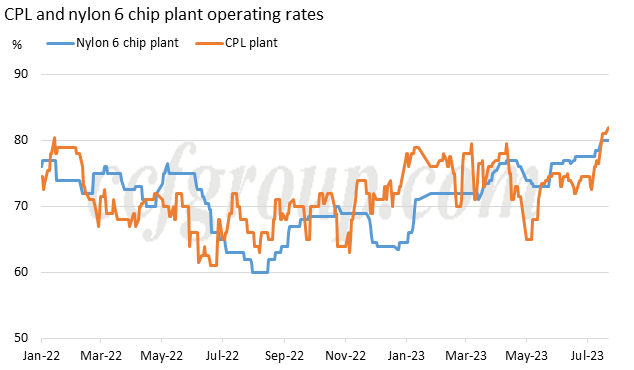What has supported high O/R in nylon industry in off-season?
Since July 17, 2023, caprolactam and average nylon 6 chip plants' operating rates had both reached 80% and stayed above. The run rate of CPL plants waved between 81-82% in late July, and that of nylon 6 chip plants was basically steady at 80%. It was for the first time in 2023 that both CPL and nylon 6 plants ran at such high rates.

CPL plants are almost running at the highest available effective capacity utilization.
According to CCFGroup's survey, China's total CPL capacity reaches 6.01 million tons/year, after Eversun Technology started up its second phase in June 2023. Among the total capacity, 600kt/year capacity (about 10% of total capacity) has been idled for long term and may not restart within a short time, which include Haili Chemical (400kt/year), Sinopec Shijiazhuang Refinery (100kt/year) and Inner Mongolia Kingho(100kt/year).
The rest of 9% capacity is shut down due to cyclohexanone cost and other facility-related reasons, which includes Nanjing Fibrant (200kt/year), Sinopec Baling Petrochemical (100kt/year), Zhejiang Juhua (50kt/year), Lanhua (40kt/year), and Dongming Risun (60kt/year).
Apart from the two kinds of long or short-term idled capacities, the rest CPL plants have been almost running at their full capacity, except for several new units, not reaching a full-capacity operation status.
If the operating rate of CPL plants would rise further, it requires below conditions:
1. CPL production profit based on merchant cyclohexanone is evidently and sustainably positive.
2. CPL production profit greatly improves, as for the long-term idled facilities will restart.
From the current economic fundamentals and the supply-demand situation of cyclohexanone within the year, the above two factors are not present. This means that there will be limited supply increment for CPL in the coming months. Of course, the imminent start of production at Sinopec Baling Petrochemical is understood. Yet, the project plans to first commence polymer production and then CPL, and the existing lines will be partially shut down before new lines are started up. Therefore, even with the startup of Sinopec Baling Petrochemical's new CPL capacity, there will not be an evident increase in CPL merchant supply.
Recently, there have been frequent instances of tight supply for CPL. Considering the above analysis, this situation should be of concern to polymer plants.
The last time the operating rate of PA6 reached 80% was in the first half of 2021. At that time, the market was mainly driven by strong export demand in downstream in the post-pandemic period, coupled with the recovery in spinning during the first half of 2021, which led to a high operating rate in polymer plants. Similarly in 2023, the unexpected price increase in the middle of this year can be attributed to the strong demand for HS chip and its downstream nylon filament.
From the demand perspective, it is evident that currently in the domestic market, the performance of different nylon 6 chips can be ranked as: dull HS chip > semi-dull HS chip> CS chip.
The strength of dull HS chip can be attributed to the surge in demand for dull nylon fabric driven by the hot sales of sun-protective clothing. As of July, the supply of dull filaments remains relatively tight.
Semi-dull HS chip is currently experiencing no pressure in sales. This is partly due to a small portion of facilities shifting their production to dull HS chip, which reduces the pressure on semi-dull HS chip. In addition, demand for HS chip is also supported by the trend of "coolness" clothes, which has expanded the demand for nylon fabric in various categories such as men's casual pants, polo shirts, women's wide-leg pants, etc. The usage of semi-dull filaments has also noticeably increased in intimate apparel and shorts, among other categories. The direct reflection of this trend is the sustained popularity of semi-dull FDY sales. Also due to the processing advantages of semi-dull HS chips over CS chips, a portion of the capacity originally designated for CS chip has also shifted to semi-dull HS chip production.
These production switches have pulled up the overall utilization of nylon 6 chip.
It was why, when CS chip market was dragged by the poor performance of real estate and automobile industries, the overall CPL-nylon 6 market is still strong. It is because HS chip market is strong enough, it has managed to withstand the situation even with the burden of less competent teammates. Therefore, with the restart of Luxi Chemical the average operating rate of nylon 6 chip has risen to above 80% as well.
Taking both CPL and nylon 6 chip market into consideration, from a supply and demand perspective, the current situation for CPL-PA6 appears to be balanced overall, making it relatively difficult to accumulate inventory. Looking at the downstream capacity to absorb CPL-PA6 as a whole, it seems that the demand for filament can still be accommodated to some extent, but there appears to be insufficient demand for modified plastics and staple fibers below CS chip sector. Therefore, as the operating rates of CPL and nylon 6 chip increase, the next potential point of conflict may return to the issue of inventory accumulation in CS chip sector, leading to a likely new round of price negotiations between the upstream and downstream sectors.
- Top keywords
- Cotton Price
- Cotton Futures Price
- Cotton Futures
- CZCE
- PTA Futures Price
- Chemical Fiber
- Polyester Prices
- Wool price
- PTA Futures
- Shengze Silk
- China
- Yarn Price
- price
- China Textile City
- Fibre Price
- Benzene Price
- Cotton
- Index
- Cotton Index
- PTA
- fabric price
- NYMEX
- Top 10
- textile industry
- Spot Cotton
- Cotton Yarn
- Polyester Price
- Futures
- PTA Price
- cotton yarn price

